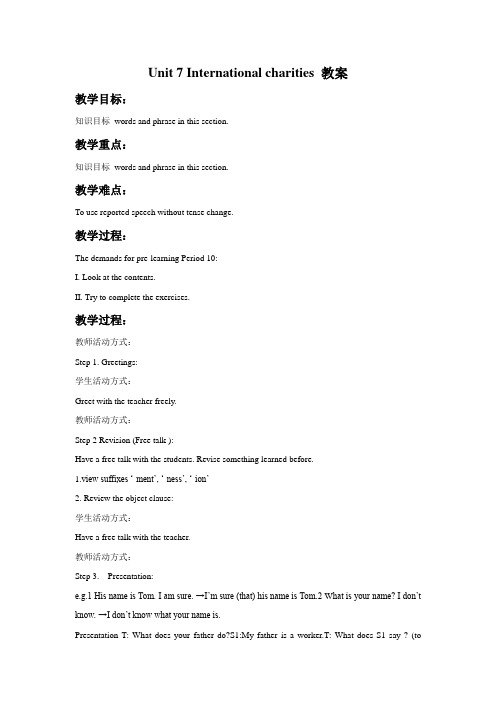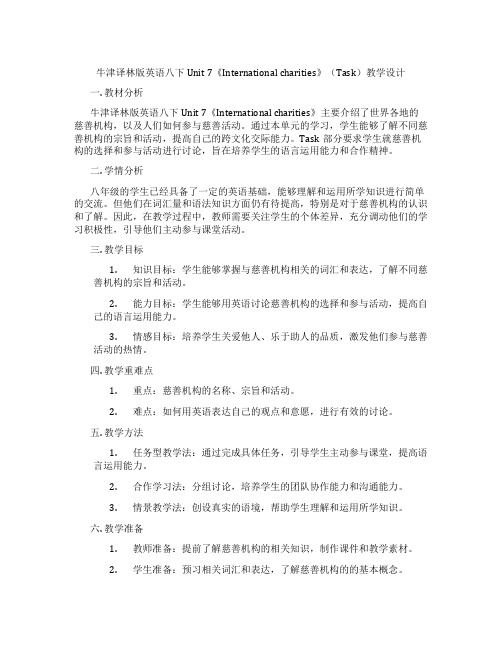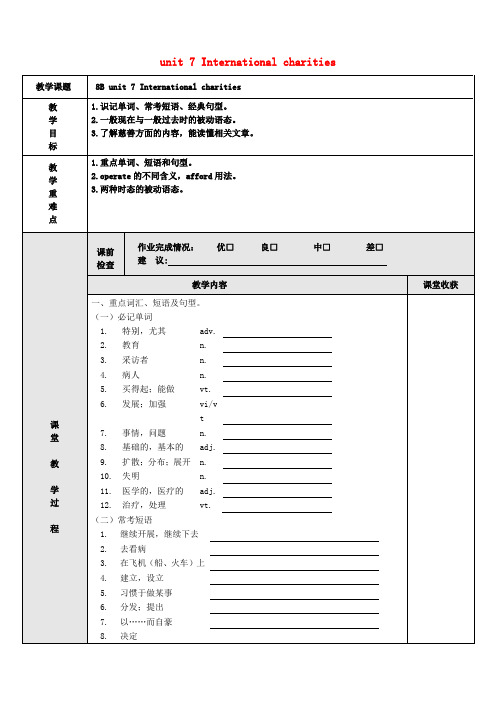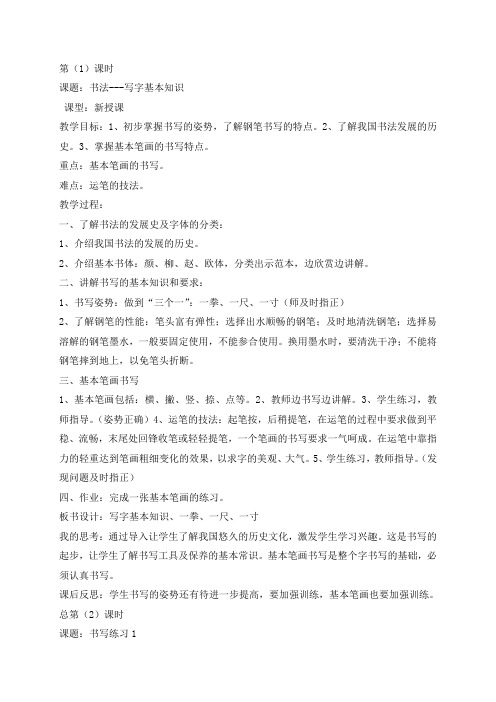Unit 7 International charities教案3-优质公开课-译林八下精品
- 格式:doc
- 大小:32.50 KB
- 文档页数:2

Unit 7 International charities 教案教学目标:知识目标words and phrase in this section.教学重点:知识目标words and phrase in this section.教学难点:To use reported speech without tense change.教学过程:The demands for pre-learning Period 10:I. Look at the contents.II. Try to complete the exercises.教学过程:教师活动方式:Step 1. Greetings:学生活动方式:Greet with the teacher freely.教师活动方式:Step 2 Revision (Free talk ):Have a free talk with the students. Revise something learned before.1.view suffixes ‘-ment’, ‘-ness’, ‘-ion’2. Review the object clause:学生活动方式:Have a free talk with the teacher.教师活动方式:Step 3. Presentation:e.g.1 His name is Tom. I am sure. →I’m sure (that) his name is Tom.2 W hat is your name? I don’t know. →I don’t know what your name is.Presentation T: What does your father do?S1:My father is a worker.T: What does S1 say ? (toSs) What did S1 say just nT& Ss: S1 says that his father is a worker. S1 said that his father is a worker.学生活动方式:Change the sentences.教师活动方式:We can use reported speech to tell people what someone else said. We do not need to change the tense if we are reporting a fact or if the information is still true. However, we may still need to change the pronoun.学生活动方式:Listen and make notes.教师活动方式:1. The teacher told his students that the sun rises in the east and sets in the west.When do you do your homework?2. Divide the class into pairs. Tell students to ask each other the following questions:What is your favourite sport?How do you go to school? Where do you live?Tell students to write down what their partner says using reported speech3. Ask a few students to present information about their partners to listen学生活动方式:Work in pairs.教师活动方式:Go through the information in the four Tip boxes on page 5.Finish the exercises(A1,A2,A3)Ask the students to read their answers。

牛津译林版英语八下Unit 7《International charities》(Task)教学设计一. 教材分析牛津译林版英语八下Unit 7《International charities》主要介绍了世界各地的慈善机构,以及人们如何参与慈善活动。
通过本单元的学习,学生能够了解不同慈善机构的宗旨和活动,提高自己的跨文化交际能力。
Task部分要求学生就慈善机构的选择和参与活动进行讨论,旨在培养学生的语言运用能力和合作精神。
二. 学情分析八年级的学生已经具备了一定的英语基础,能够理解和运用所学知识进行简单的交流。
但他们在词汇量和语法知识方面仍有待提高,特别是对于慈善机构的认识和了解。
因此,在教学过程中,教师需要关注学生的个体差异,充分调动他们的学习积极性,引导他们主动参与课堂活动。
三. 教学目标1.知识目标:学生能够掌握与慈善机构相关的词汇和表达,了解不同慈善机构的宗旨和活动。
2.能力目标:学生能够用英语讨论慈善机构的选择和参与活动,提高自己的语言运用能力。
3.情感目标:培养学生关爱他人、乐于助人的品质,激发他们参与慈善活动的热情。
四. 教学重难点1.重点:慈善机构的名称、宗旨和活动。
2.难点:如何用英语表达自己的观点和意愿,进行有效的讨论。
五. 教学方法1.任务型教学法:通过完成具体任务,引导学生主动参与课堂,提高语言运用能力。
2.合作学习法:分组讨论,培养学生的团队协作能力和沟通能力。
3.情景教学法:创设真实的语境,帮助学生理解和运用所学知识。
六. 教学准备1.教师准备:提前了解慈善机构的相关知识,制作课件和教学素材。
2.学生准备:预习相关词汇和表达,了解慈善机构的的基本概念。
七. 教学过程1.导入(5分钟)教师通过向学生介绍自己参与的慈善活动,引发学生对慈善机构的兴趣,导入新课。
2.呈现(10分钟)教师展示慈善机构的图片和相关信息,引导学生关注慈善机构的名称、宗旨和活动。
3.操练(15分钟)学生分组讨论,每组选择一个慈善机构,用英语介绍其宗旨和活动。

unit 7 International charities我8. prevent the m from getting illness 8. aThe cla课后练习一、单词拼写(10%)1. We should think about continuing to_______(发展) this wonderful project.2. I need two more_______(秘书) to help me finish the task.3. Remember to take the (药) three times a day.4. I really hope there is no_______ (战争) any more in the world.5. It is warm all year round and sometimes is very hot in Kunming, _______ (尤其) in May and June.6. Now I will show you some_______ (基本的) examples of using them.7. Are you ready? The_______ (采访者) have prepared a lot of questions.8. -Can you help me out these leaflets to people in the street?-Sure.9. -What's the with you, Andy?-I'm not getting along well with Laurence and I don't know how to make up with him. .10.-What do children in poor areas need most?- _______. Every child has the right to go to school.二、单项填空(20%)( ) 1. I think it's _______ useful advice, so I will always remember it.A. aB. anC. theD. /( ) 2. The girl is _______ young _______ loo k after herself.A. so; thatB. too; toC. very; toD. so; to( ) 3. English _______ in many countries, but the Chinese _______ their own language.A. speaks; spokenB. is spoken; is spokenC. is spoken; speakD. is spoken; speaks( ) 4. In China, the old _______.A. are taken good care ofB. are taken good careC. is taken good care ofD. is taken good care( ) 5. Our monitor has w on the first prize in the competition, and we are very _______ him.A. busy withB. famous forC. good atD. proud of( ) 6. To protect the environment, most supermarkets have stopped ______ free plastic bags.A. to sendB. sendingC. to provideD. providing( ) 7. Carry _______ while I'm away.A. on with your workB. workingC. on to workingD. with working( ) 8. _______ of the people in the North live on wheat. They live _______ on wheat.A. Mostly; mostB. Most; mostlyC. Mostly; almostD. Most; almost( ) 9. -Nancy, you are going to buy a flat here, aren't you?-Yes, but I can't _______ an expensive one.A. spendB. pay.C. costD. afford( )10. The man had something wrong with his nose so he _______.A. operate onB. was operatedC. was operated onD. operation on( )11.-Is your brother a Swimming Club member?-Yes, he _______ the club three years ago. He _______ a club member for three years.A. joined; has beenB. joined; has been inC. joined in; isD. joined in; has been( )12. The government will _______ more colleges for more students to receive higher education.A. set upB. send upC. set outD. use up( )13. The bird _______ to fly away yesterday.A. let toB. is letC. was letD. was letting( )14. _______ meaningful work it is to raise money for charities !A. HowB. WhatC. How aD. What a( ) 15. John _______ living in the countryside because he _______ the environment there.A. was used to; used toB. is used to; is used toC. used to; is used toD. used to; was used to( )16. We must _______ computer games too much.A. keep students from playingB. prevent students from playingC. stop students from playingD. all the above( )17. The singer sang many pop songs, _______ some of my favourites.A. includeB. includingC. includedD. includes( )18. -How many cakes can I have, Mum?-None, dear. They _______ for your father.A. prepare B prepared C. have prepared D. were prepared( )19.-Is your sister ill? -No, _______, only a little cold.A. serious anythingB. nothing seriousC. serious nothingD. anything serious( )20. -I don't know how to search the Internet. - _______. I'll help you.A. I hope soB. I'm afraid, tooC. Don't worryD. I'm sorry三、动词填空(10%)1. The Olympic Games_______ (hold) every four years.2. -Excuse me. Look at the sign "No Photos". -Sorry, I -_______ (not notice) it.3. Project Hope _______ always_______ (support)by those kind people.4. Many doctors on the flying hospital fly to poor areas_______ (treat) people with eye problems.5. The doctors_______ (operate) on the girl when we got to the hospital.6. -What's your plan for the coming holiday?-I _______ (visit) Beijing if possible.7. Bamboo _______ usually _______ (use) to make kites during Qing Dynasty.8. I'm not familiar with this place. It's the first time I _______ (be) here, you know.9. -When _______ we_______ (meet) tomorrow? -I have no idea.10. -Who_______ (organize) this fashion show?-Millie does.四、完形填空(10%)Charity walks are a great way for a charity to raise money. The charity organizes a time and place for people to meet and decides 1 the walk will be. Most charity walks are 2 20 and 30 kilometres long, but some can be as long as 1,000 kilometres. The charity often advertises the 3 on the television, radio and also in local newspapers so that lots of people can take part in the walk. The charity 4 money through the people's walking in the event. Each person asks his or her friends to sponsor(赞助) them and then 5 the money from them when they finish the walk. 6 , a person might ask their friends to give 5 yuan for every kilometre that he or she walks. This is a good way 'for people to raise money, if they are not very healthy and wonder if they 7 finish the route. There are lots of different charities in today's world, so it is important for a charity to remind(提醒) people about 8 they do. Even though(即使) people might see a charity's logo(标识) often, having a charity walk is a great 9 to remind them about it. When people know what the charity is raising money for, they will donate some money. In this way, the next time those people feel generous, they may decide to give their money to the charity, 10 a different one.( ) l. A. how long B. how soon C. how often D. how much( ) 2. A. either B. both C. among D. between( ) 3. A. game B. sport C. walk D. idea( ) 4. A. runs B. raises C. holds D. asks( ) 5. A. borrows B. gives C. collects D. makes( ) 6. A. But B. Such asC. To tell the truthD. For example( ) 7. A. must B. can C. need D. should( ) 8. A. what B. how C. where D. why( ) 9. A. problem B. way C. road D. hope( )10. A. while B. instead of C. but D. without五、阅读理解(20%)(A)Perhaps your childhood piano lessons made you never want to play the piano again. Perhaps a piano is too expensive for you to buy. Now thanks to a program in Sydney called "Play Me, I'm Yours", people are able to play the piano in public places. for free. They share beautiful music and the program also helps them communicate with each other.Thirty pianos have been placed in different parts of the city including in several parks, at a bus stop and on some streets. The pianos have the logo "Play Me, I'm Yours" on them. People arc invited to play music or sing songs with the pianos. Lots of people have been attracted (吸引) to the program and stopped to watch or play the pianos."Play Me, I'm Yours" is a part of the Sydney Festival. It is a project of the British artist Luck Jerram. He wants to help people in the city connect with each other. He thinks that so many people are sitting in front of computers and busy with their work all hours and they almost have no chance to enjoy music. So the purpose of the project is to help them relax and make new friends.The program "Play Me, I'm yours" has also reached England and Brazil (巴西) before. It was warmlywelcomed there. But its greatest success seems to come at the Sydney Festival. "It's a chance for people to connect with strangers (陌生人) and just have some fun, " Jerram said.( ) 1. According to the first sentence of the passage, your childhood piano lessons may be _______.A. boringB. wonderfulC. interestingD. meaningful( ) 2. Thirty pianos are placed in parts of the city except _______.A. in parksB. at a bus stopC. on streetsD. in a school( ) 3. The purpose of the project is to help people _______.A. sing songsB. play the piano for freeC. relax and make friendsD. enjoy beautiful music( ) 4._______ countries have had the program.A. TwoB. ThreeC. FourD. Five( )5. What can be the title(标题)for the passage?A. Beautiful MusicB. A British Artist, Luck JerramC. The Sydney FestivalD. A Program "Play Me, I'm Yours"(B)Come to Austria(奥地利)Soll is a village in the mountains in western Austria. And the Post Hotel is clean and not expensive. It is opened by a local family. From the hotel you can see the whole village, the forests and the mountains. Temperatures in summer are usually 20 to 25 in the daytime, but much cooler by evening.Enjoy Thailand!When you visit Bangkok in Thailand, don't miss the early morning river boat trip to the Floating Market just outside the city. There you will find-many kinds of fruit and vegetables. And you can pay for them when you sit in your boat. Don't forget your hat: the sun can-be strong and it may be as hot as 40 at noon.Visit Hawaii!Maybe the most beautiful place in Hawaii is Kauai. You can visit its long, sandy beaches in the south and west of the island, and mountains and forests in the north, but don't be surprised if it rains in the centre of the island. Daytime temperatures there are usually around 24 to 26 by the sea, and only a little cooler by late evening.( ) 6. The advertisements above are about _______.A. shoppingB. foodC. travelD. hotels( )7. If you go to Bangkok, you can_______.A.climb mountainsB. enjoy the scenery(景色)of the forestsC.live in the Post HotelD. buy fruit while sitting in your boat( )8. _______ is one way to prevent the strong sunshine in Bangkok.A. Going to the sandy beachesB. Wearing a hatC. Climbing up the mountainsD. Staying in the forests( ) 9. Which place will you choose if you wan-t to visit both mountains and beaches?A. Soll in Austria.B. Bangkok in Thailand.C. The Floating Market.D. Kauai in Hawaii.( )10. According to(根据)the advertisements, we know that _______.A. the hottest travel place is SollB. maybe it often rains in the centre of KauaiC. the Floating Market is in the middle of BangkokD. the temperature isn't very high in these places六、句子翻译(15%)1.上护士被邀请上飞机了解眼部问题。

牛津译林版八年级下册Unit 7《International charities》教学设计3一. 教材分析《International charities》是人教版牛津译林八年级下册Unit 7的一篇阅读课文,主要介绍了国际慈善机构的意义和作用。
本文通过讲述不同慈善机构帮助世界各地需要帮助的人的故事,使学生了解慈善机构的重要性,提高学生的社会责任感和关爱他人的意识。
二. 学情分析八年级的学生已经具备了一定的阅读理解能力,对于生活中的慈善机构有一定的了解,但可能对国际慈善机构的具体情况了解不多。
因此,在教学过程中,教师需要帮助学生更好地理解课文内容,激发学生关爱他人、积极参与慈善活动的热情。
三. 教学目标1.知识目标:学生能够掌握课文中的关键词汇和句型,理解课文大意。
2.能力目标:学生能够运用所学知识,进行简单的阅读理解和口语表达。
3.情感目标:学生能够了解国际慈善机构的意义和作用,培养关爱他人、积极参与慈善活动的意识。
四. 教学重难点1.重点:课文的理解和词汇的掌握。
2.难点:课文中的长句和复杂句子结构的理解,以及如何运用所学知识进行实际的阅读理解和口语表达。
五. 教学方法1.任务型教学法:通过设定各种任务,让学生在完成任务的过程中,自然地学习和掌握知识。
2.情境教学法:创设真实的语境,让学生在特定的情境中学习和运用英语。
3.合作学习法:鼓励学生之间互相合作,共同完成学习任务。
六. 教学准备1.课文原文及配套练习题。
2.与课文内容相关的图片、视频等教学资源。
3.录音机、投影仪等教学设备。
七. 教学过程1.导入(5分钟)利用图片或视频展示一些国际慈善机构正在进行的活动,引导学生关注慈善机构的重要性,激发学生的学习兴趣。
2.呈现(10分钟)老师简要介绍课文内容,然后让学生阅读课文,理解大意。
在阅读过程中,老师可以随时回答学生的问题,帮助学生理解课文。
3.操练(15分钟)学生分角色朗读课文,模仿课文中的对话。

Period 3 Reading II(An interview with an ORBIS doctor)Teaching goals●To work out the structure of each sentence●To retell the story in their own words, following the organization of thepassage●To explain all the language pointsTeaching proceduresStep 1 Reading the text togetherRead the passage on page 78 and 79 together loudly.I may choose some of you to read the passage paragraph by paragraph later on. Step 2 Making a flow chart on ORBISGo over the text to make a flow chart on ORBIS, getting ready for retelling. You can use the flow chart on page 88 as a model.Now try to retell the text story in your own words with the help of the flow chart.Step 3 Retelling the storyBlindness affects about 45 million people around the world, m_____ in poor countries. In fact, about 80 per cent of the cases of blindness can be c_____ or p_____. However, many people don’t ha ve e_____ money for m_____ t_____.ORBIS is a c_____ that helps the poor with e_____ problems. It uses a f_____ eye hospital to visit poor countries. On the plane, v_____ doctors p_____ o_____. They also use the plane as a t_____ c_____.The doctors don’t work in a hospital but on a plane, because many of their p_____ are so p_____ that they don’t have the money to t_____ to hospital. So the ORBIS doctors have to go to them. They also t_____ the l_____ doctors and nurses new s_____and k_____ .They hope to help more people by t_____ them.Dr. Ma is a doctor on the ORBIS plane. He o_____ on 150 patients on the plane during his last v_____ . It’s hard work but he is used to it now. Of course, many people are very g_____ to him because he has helped them see again. He believes that m_____ m_____ can be useful to the cases of blindness. All they need is e_____ money to c_____ on with their work. So he hopes that more and more people will support their by sending donations to ORBIS.Step 4 Explaining language pointsWhat questions do you have about the following language points? Now make sentences of your own with them.1. operate on sb.=perform/do an operation on sb.2. used to do/ be used to doing3. so…that/such…that4. carry on with…5. be proud to do/ be prou d of…6. improve one’s life7. be grateful to sb. for sth.Step 5 Doing additional exercises用所给词组的适当形式填空(有一个多余)1.He was hurt __________ badly ___________ we had to send for a doctor.2.The little girl ____________ washing her hands before meals now.3.I am ____________ Liu Xiang because he is the pride of our country.4.I ___________ spend my pocket money playing computer games. It’s bad for mystudy.5.The old doctor ______________ the patient last Sunday.6.We need enough money __________ our work, so we need your support.Step 6 Doing an extension activitya.Think about what we can do to support ORBIS.b.Introduce one charity that you know very well.Step 7 Homeworka. Act out the interview.b. Tell your parents about ORBIS.答案:Step 3(Keys: mostly, cured, prevented, enough, medical treatment, charity, eye, flying, volunteer, perform, operations, Teaching, center, patients, poor, travel, teach, local, skills, knowledge, treating, operated, visit, grateful, modern, medicine, enough, carry)Step 5(Keys: so…that, is used to, proud of, used to, operated on, to carry on )。

第(1)课时课题:书法---写字基本知识课型:新授课教学目标:1、初步掌握书写的姿势,了解钢笔书写的特点。
2、了解我国书法发展的历史。
3、掌握基本笔画的书写特点。
重点:基本笔画的书写。
难点:运笔的技法。
教学过程:一、了解书法的发展史及字体的分类:1、介绍我国书法的发展的历史。
2、介绍基本书体:颜、柳、赵、欧体,分类出示范本,边欣赏边讲解。
二、讲解书写的基本知识和要求:1、书写姿势:做到“三个一”:一拳、一尺、一寸(师及时指正)2、了解钢笔的性能:笔头富有弹性;选择出水顺畅的钢笔;及时地清洗钢笔;选择易溶解的钢笔墨水,一般要固定使用,不能参合使用。
换用墨水时,要清洗干净;不能将钢笔摔到地上,以免笔头折断。
三、基本笔画书写1、基本笔画包括:横、撇、竖、捺、点等。
2、教师边书写边讲解。
3、学生练习,教师指导。
(姿势正确)4、运笔的技法:起笔按,后稍提笔,在运笔的过程中要求做到平稳、流畅,末尾处回锋收笔或轻轻提笔,一个笔画的书写要求一气呵成。
在运笔中靠指力的轻重达到笔画粗细变化的效果,以求字的美观、大气。
5、学生练习,教师指导。
(发现问题及时指正)四、作业:完成一张基本笔画的练习。
板书设计:写字基本知识、一拳、一尺、一寸我的思考:通过导入让学生了解我国悠久的历史文化,激发学生学习兴趣。
这是书写的起步,让学生了解书写工具及保养的基本常识。
基本笔画书写是整个字书写的基础,必须认真书写。
课后反思:学生书写的姿势还有待进一步提高,要加强训练,基本笔画也要加强训练。
总第(2)课时课题:书写练习1课型:新授课教学目标:1、教会学生正确书写“杏花春雨江南”6个字。
2、使学生理解“杏花春雨江南”的意思,并用钢笔写出符合要求的的字。
重点:正确书写6个字。
难点:注意字的结构和笔画的书写。
教学过程:一、小结课堂内容,评价上次作业。
二、讲解新课:1、检查学生书写姿势和执笔动作(要求做到“三个一”)。
2、书写方法是:写一个字看一眼黑板。
牛津译林版八年级下册Unit 7《International charities》教学设计一. 教材分析牛津译林版八年级下册Unit 7《International charities》主要介绍了国际慈善以及它们在世界各地为解决贫困、疾病和教育问题所做出的努力。
本单元通过讲述一些慈善的故事,让学生了解慈善的目的、工作方式以及如何为慈善做贡献。
教材内容丰富,贴近学生生活,能够激发学生的学习兴趣,培养学生的同情心和爱心。
二. 学情分析八年级的学生已经具备了一定的英语基础,能够听、说、读、写简单的英语句子。
但他们在阅读和写作方面还存在一定的困难,特别是对于长篇文章的理解和分析能力较弱。
此外,学生对于慈善的了解较少,可能对教材内容产生陌生感。
因此,在教学过程中,教师需要关注学生的个体差异,调动学生的积极性,帮助他们更好地理解和掌握教材内容。
三. 教学目标1.知识目标:让学生掌握慈善的目的、工作方式以及如何为慈善做贡献的相关词汇和表达方式。
2.能力目标:培养学生具备阅读和理解关于慈善的长篇文章的能力,提高学生的听说读写技能。
3.情感目标:激发学生的同情心和爱心,培养他们关注社会问题、积极参与慈善活动的意识。
四. 教学重难点1.重点:慈善的目的、工作方式以及如何为慈善做贡献的相关词汇和表达方式。
2.难点:对于长篇文章的理解和分析,以及如何在实际情境中运用所学知识。
五. 教学方法1.任务型教学法:通过设置各种任务,让学生在完成任务的过程中学习和运用英语,提高他们的实际运用能力。
2.情境教学法:创设真实的教学情境,让学生在情境中感受和体验英语,激发他们的学习兴趣。
3.合作学习法:鼓励学生分组合作,共同完成学习任务,培养他们的团队精神和沟通能力。
六. 教学准备1.教材:牛津译林版八年级下册Unit 7《International charities》2.多媒体教学设备:用于展示图片、视频等教学资源3.教学资源:相关慈善的资料、新闻报道等4.练习题:用于巩固所学知识七. 教学过程1.导入(5分钟)利用多媒体展示一些慈善的图片,引导学生谈论慈善,激发他们的学习兴趣。
Unit 7 International charities 教案
教学目标:
知识目标words and phrase in this section.
教学重点:
知识目标words and phrase in this section.
教学难点:
To use reported speech without tense change.
教学过程:
The demands for pre-learning Period 10:
I. Look at the contents.
II. Try to complete the exercises.
教学过程:
教师活动方式:
Step 1. Greetings:
学生活动方式:
Greet with the teacher freely.
教师活动方式:
Step 2 Revision (Free talk ):
Have a free talk with the students. Revise something learned before.
1.view suffixes ‘-ment’, ‘-ness’, ‘-ion’
2. Review the object clause:
学生活动方式:
Have a free talk with the teacher.
教师活动方式:
Step 3. Presentation:
e.g.1 His name is Tom. I am sure. →I’m sure (that) his name is Tom.2 W hat is your name? I don’t know. →I don’t know what your name is.
Presentation T: What does your father do?S1:My father is a worker.T: What does S1 say ? (to
Ss) What did S1 say just nT& Ss: S1 says that his father is a worker. S1 said that his father is a worker.
学生活动方式:
Change the sentences.
教师活动方式:
We can use reported speech to tell people what someone else said. We do not need to change the tense if we are reporting a fact or if the information is still true. However, we may still need to change the pronoun.
学生活动方式:
Listen and make notes.
教师活动方式:
1. The teacher told his students that the sun rises in the east and sets in the west.When do you do your homework?
2. Divide the class into pairs. Tell students to ask each other the following questions:
What is your favourite sport?
How do you go to school? Where do you live?
Tell students to write down what their partner says using reported speech
3. Ask a few students to present information about their partners to listen
学生活动方式:
Work in pairs.
教师活动方式:
Go through the information in the four Tip boxes on page 5.Finish the exercises(A1,A2,A3)
Ask the students to read their answers。
课后达标:
It’s easy for the students to forget some details e. g change the tense.。